Discover the Fascinating World of 10 Incredible Creatures

Embark on a captivating journey as we unveil 10 extraordinary creatures that defy imagination. From shimmering underwater wonders to majestic creatures of the sky, this blog post showcases the awe-inspiring beauty and diversity of our natural world. Prepare to be amazed as we delve into the remarkable features and fascinating behaviors of these captivating beings. Get ready to witness nature’s marvels like never before in this collection of stunning photographs and intriguing insights.
#01 Ready for the disco

#EarthCapture by Pavan Kumar
Believe it or not, you’re about to encounter a mesmerizing creature! Allow us to introduce you to the chrysilla volupe, a spider that can easily be considered the most vibrant and colorful in the entire world. While this specific species of jumping spider is commonly found in India and Sri Lanka, it’s worth noting that the jumping spider family encompasses a staggering array of over 6,000 distinct species! Prepare to be amazed by the remarkable diversity within this fascinating arachnid family.
#02


#EarthCapture by jamie_hall_definitive_imaging
The triangular spider found in Australia is a cunning predator that employs its enormous, spiky forelegs to ensnare unwary prey in a clever ambush tactic.
#03 Table manners

#EarthCapture by Jens Wikström
Southern elephant seals hold the title of being the largest among all seal species. With males reaching lengths of over six meters and weighing nearly 4,000kg, they are truly impressive creatures. These seals engage in fierce battles for dominance, using aggressive roars to assert their authority. However, on certain occasions, these confrontations escalate into physical altercations.
#04 Wasssup

#EarthCapture by Rainer Armbruster
Contrary to its name, the European green toad is not limited to Europe but can also be spotted in various regions of Asia and North Africa. Referred to as “the changeable toad,” this unique amphibian possesses the remarkable ability to alter its coloration in accordance with shifts in light and temperature within its surroundings.
#05 Blue beauties! 😍

#EarthCapture by Thomas Hinsche
Originating from the western Pacific Ocean, the white-spotted jellyfish, scientifically known as phyllorhiza punctata, is a type of jellyfish. Interestingly, these jellyfish possess such a mild sting that they do not rely on it for capturing food. Instead, they are skilled filter feeders with the ability to filter enormous quantities of seawater in their search for plankton.
#06 Pretty fly for a neck tie 👔

#EarthCapture by (vaaarad_7 via Instagram)
The fan-throated lizard earns its name from the vibrant exhibition of color on its throat. To attract a mate, male lizards frequently assume a distinctive posture where they extend and expand their throats in an eye-catching display.
#07 Nature Frock

#EarthCapture by (vaaarad_7 via Instagram)
Decapodiformes are a group of marine creatures that includes squids, cuttlefish, and octopuses. They are known for their tentacles and unique ability to propel themselves through the water using jet propulsion. These fascinating animals display remarkable intelligence and have the ability to change colors and camouflage themselves for various purposes, such as communication, hunting, and defense.
#08 Adding this guy to the long boy club. 

#EarthCapture by Nightfall Photography
The mud dauber wasp boasts a sleek and aerodynamic body shape. Despite their intimidating appearance, stinging incidents are infrequent. These wasps are typically non-aggressive unless intentionally agitated. Their name is derived from their unique nesting behavior, as they construct their nests using mud.
#09 Such a tiny frog

#EarthCapture by Walter Rodriguez via Instagram
Mimic poison frogs, scientifically known as Ranitomeya imitator, are tiny beings with an average size of merely 1.3cm! Contrary to their name, they do not possess highly toxic properties. Instead, their vibrant coloration mimics that of more venomous species, serving as a form of protective deception.
#10 Up close and personal 🔍

#EarthCapture by @neverchangeyoufortheworld via Instagram.
Bronze shieldbugs, scientifically referred to as Troilus luridus, undergo several developmental stages called instars. The image depicts a nymph in its final instar, which exhibits one of two possible color variations during this stage.




